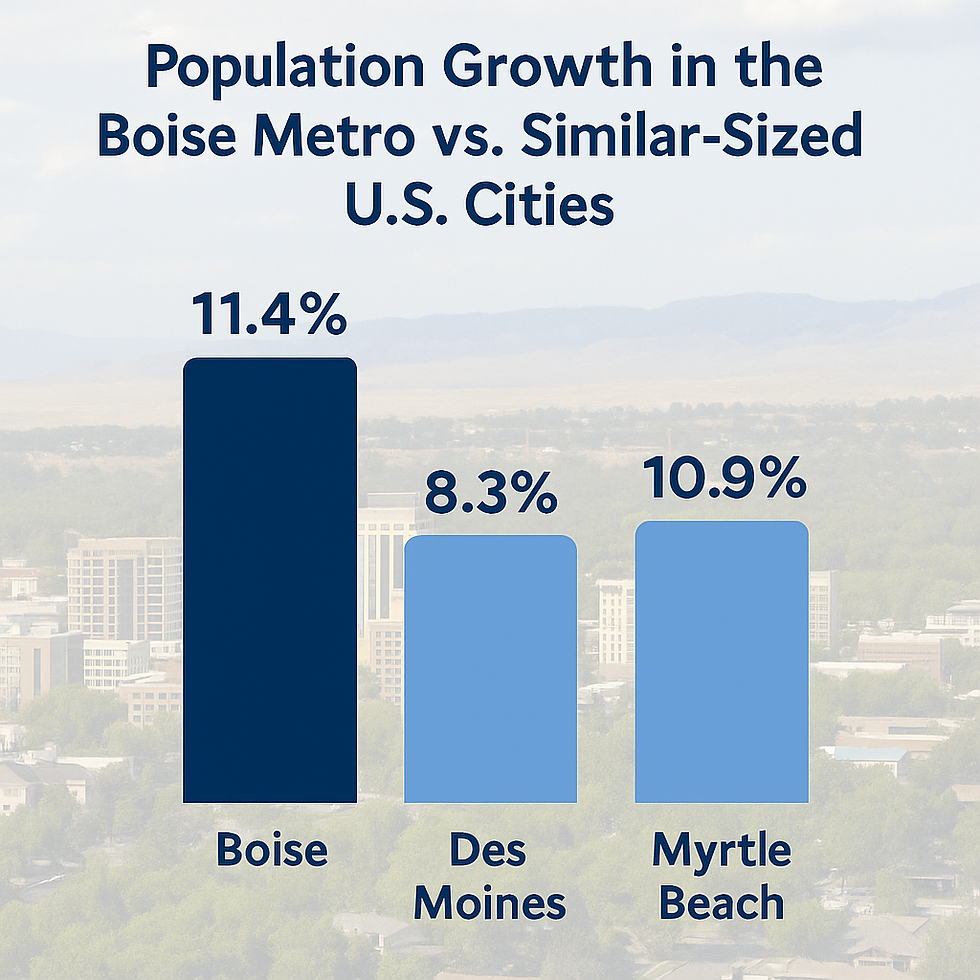Boise Metro Population Growth: What It Means for Housing and the Community
- The BBRE Team

- 5 days ago
- 3 min read
Boise has been one of the fastest-growing metro areas in the United States for years, and the trend doesn’t appear to be slowing down. The combination of a thriving job market, outdoor lifestyle, and relatively affordable cost of living (compared to coastal cities) has drawn people from across the country. But what does this surge in population mean for the housing market, infrastructure, and overall quality of life in the Treasure Valley?

Why Is Boise Growing So Fast?
Boise's growth can be attributed to several factors:
Affordability: While home prices have risen sharply in recent years, Boise remains more affordable than markets like Seattle, Portland, and California cities.
Quality of Life: Access to nature, low crime rates, and a strong sense of community make Boise appealing to families and retirees.
Remote Work Boom: Many professionals are leaving expensive metro areas while keeping their jobs, making Boise a desirable place to live.
Job Opportunities: With growth in tech, healthcare, and manufacturing, the Boise economy is providing stable jobs that attract newcomers.
Impact on Housing Prices
Population growth has created intense competition in the housing market. With more buyers than available homes, prices have surged, and bidding wars have become common. Builders are working hard to keep up with demand, but construction costs and labor shortages continue to make new homes more expensive. Renters are also feeling the pinch as vacancy rates remain low and rental prices increase.
Infrastructure and Traffic Concerns
As Boise grows, so do concerns about infrastructure. Traffic congestion, school crowding, and the need for expanded public services are becoming more apparent. Local governments are racing to upgrade roads, utilities, and public facilities to keep up with demand.
How Population Growth Impacts Buyers and Sellers
For buyers, this growth means acting fast and being prepared for competition. A well-prepared offer with strong financing is crucial. For sellers, this is an opportunity to take advantage of a high-demand market to sell quickly and often above asking price.
What Does the Future Hold?
Boise's population is expected to continue growing, though perhaps at a slightly slower pace due to higher home prices. As more people discover the area’s appeal, we could see continued pressure on housing and infrastructure. However, with careful planning and community investment, Boise can maintain its charm while welcoming newcomers.
Final Thoughts
Population growth is reshaping Boise and the Treasure Valley. Whether you’re buying, selling, or just watching the market, understanding these shifts can help you navigate the future. If you’re thinking about moving to or within the Boise area, now is a great time to explore your options with the help of a local expert.
Comparing Boise’s Population Growth to Peer Metro Areas
Boise vs. Comparable Mid‑Size Metro Areas
Boise City metro is projected to grow by approximately 11.41% from 2023 to 2028, with current population near 806,800 increasing toward 898,900 . That rate places Boise near the top of mid-size metro growth rankings, only trailing Provo‑Orem, Utah (~14.1%) and just ahead of Myrtle Beach (~10.9%) and Des Moines (~8.3%)
Annual Growth Rate in Boise
From 2022 to 2023, Boise City itself grew from ~234,192 to ~235,701—about 0.64% annual growth . Suburban cities like Meridian, Nampa, and Caldwell are outpacing the core—Meridian and Caldwell posted growth near 5.2%, and Nampa grew ~5% in one year.
Comparison with Des Moines and Austin
Des Moines–West Des Moines metro is projected to grow around 8.3% through 2028 from ~726,100 to ~786,300 BoiseDev+10Site Selection Group+10Reddit+10.
Austin–Round Rock metro is a much larger metro (~2.3M) but in 2025 reported a slower annual growth rate—about 0.48%, with a 2.43% increase since 2022 WikipediaMacrotrends.
Idaho vs. National and State Trends
Idaho as a state has seen growth of 22.5% between 2010–2023, second‑highest in the nation. Its 2023 statewide growth rate was about 1.43% per year World Population Review. Urban cities in Idaho grew faster than the state average between 2023–2024 at 1.8%, versus 1.5% statewide.
Growth Rates
Region / Metro Area | Metro Population (2023 est) | Projected 2023–28 Growth | Annual Growth Rate¹ |
Boise Metro, ID | ~806,800 | ~11.41% | ~1.8% (metro) / ~0.64% (city) |
Provo–Orem, UT | ~710,900 | ~14.09% | ~2.6% |
Des Moines, IA Metro | ~726,000 | ~8.30% | ~1.6% |
Myrtle Beach, SC–NC Metro | ~522,300 | ~10.91% | ~2.1% |
Austin–Round Rock Metro, TX | ~2.3M | n/a (2.43% since 2022) | ~0.48% (city) |
Idaho State (overall) | ~2.0M | n/a (22.5% since 2010) | ~1.43% (2023) |
City- or metro-level annual rates vary; figures reflect city core vs broader metro where applicable.




Comments